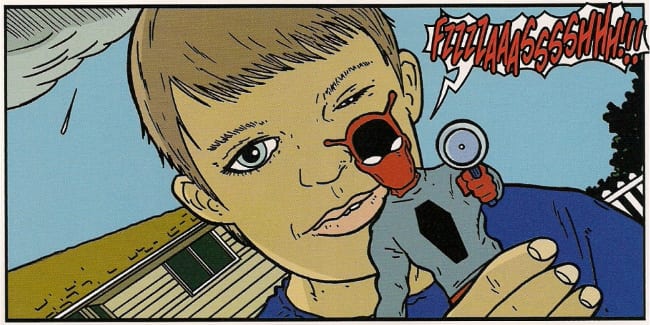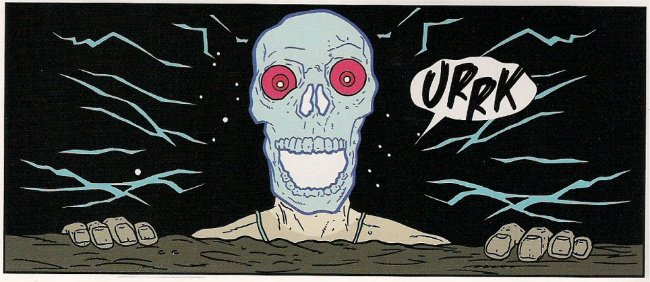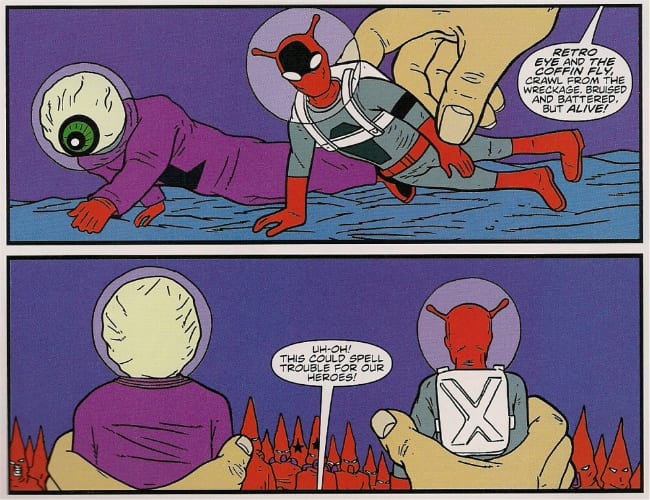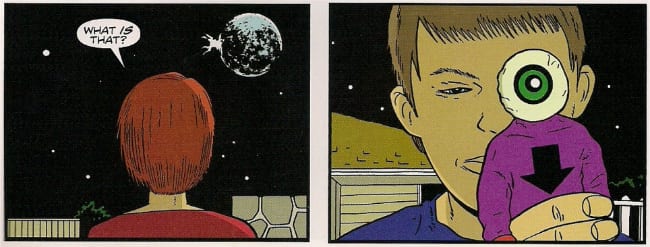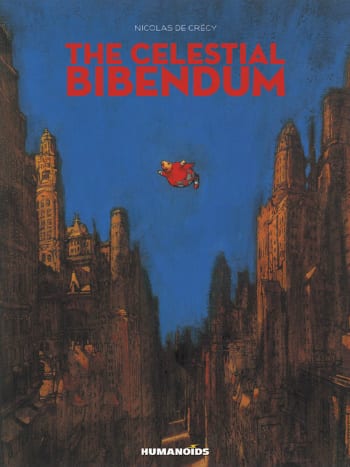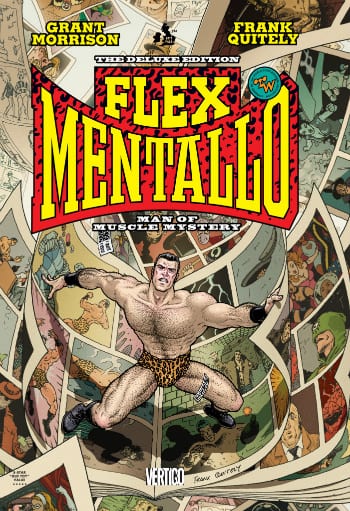A lot of the time it's a toss-up as to what I'm going to cover up here, which makes for good contrast with what I cover below, seeing as how it's always prescribed for me. This week I knew I wanted to separate things further, to go over one of the comics I follow steadily but I don't actually mention down below - an ongoing series, something where I'd run out of things to say 'blind,' but where I'd nonetheless find something to mention upon reflection.
I was thinking maybe the new Judge Dredd Megazine (#321), which is not actually the new issue, but the newest one to arrive physically in North America. There's a great reprint book bundled in, with this 1979 serial titled Angel, about a fighter pilot who becomes fused with his onboard computer after an explosion, which gives him the ability to flicker his body at lightning speed, contorting his muscles so that he can survive any fall, which I think is the dynamic tension Charles Atlas teaches you once you've gambled a stamp. Naturally, this leads to Our Hero leaping out of a spaceship in Earth's orbit, diving through the planet's atmosphere and flexing his muscles in just the right way so that he lands daintily on two feet in the good English countryside before hijacking a police cruiser, hotwiring it into his arm and remotely willing it into a Dukes of Hazzard jump over a road blockade in time to foil a saboteur's plot against the British space program.
It was the only serial completed by script droid Chris Stevens before getting himself packed up and returned to the manufacturer, as its content was OTT even by Tharg's '70s standards; nonetheless there's a terrific sense of childlike play to the action, if only by way of an adult writer presuming that the magazine's child audience is likely a bit stupid with all these fucking aliens and shit.
Today, of course, a sense of unfettered play is a valued thing in genre comics, yet clever creators still find a way to poke at their readership. As soon as folks began discussing Deadline in the comments last week, I knew the real topic of today's topper could only be a contributor to that famed forum: old-time Comics Comics favorite, Mr. Shaky Kane, whose cover to our fourth and final print issue depicted (among other things) a pair of superheroes -- the buggy Coffin Fly and the all-seeing Unforgiving Eye -- staring down accusingly at the reader with clubs in their hands. As luck would have it, they are also the heroes of last week's finest superhero selection and Kane's latest release, Image's The Bulletproof Coffin: Disinterred #3, the very best issue so far of a continuing project by the artist and writer David Hine.
What you see above is not a sequence from issue #3, however, but a panel from that issue paired with its responsive panel from issue #1, which began with the nostalgist reader surrogate character from the first Bulletproof Coffin series crawling out of his grave, only to have his head shot off by Coffin Fly, whose identity he had assumed in the initial storyline. That earlier work was a sort of tainted propaganda, positioning the 'hero' as a disturbed comics collector who stands for the superiority of the past over the fallen state of the present, finally becoming undead and living inside his precious fantasy worlds when he's unable to cope with the real life compromises made by David Hine & Shaky Kane, past-their-prime comics creators who are also characters in the book.
The format of Disinterred is different; it's ostensibly a series of comics the Hine & Kane from the first series create following their hit comics adaptation of the 'true' events of the first series, while essays in the back of each issue track the acrimonious dissolve of their partnership. As a result, the second series is modular, with each issue self-contained, focusing on a different superhero as the presence of sinister Heavy Metal (the movie)-like space rocks joins them together, possibly affecting their sanity. But there are differing levels of 'reality' at play, as the death (again) of the first series' hero in issue #1 is replayed -- and possibly commanded -- by the literal play of a child in the new issue #3, beating the crap out of his beloved action figures before calling his mom a bitch and retreating from adult supervision into a signal-free anti-Communist fantasia reminiscent of Kane's sequential art showcase Monster Truck in its fanciful decoration.
That's almost the entire plot of the issue, but what's fascinating about it is how Hine's scenario allows for Kane himself to play with the often posed, mannered look of his superhero characters; often we'll see the child playing with his action figures -- which look basically like little Kane people anyway -- only to segue into 'real' action where the superheroes move in much the same posed manner as figures being stood up in combat scenes. It's quite a clever presentation of Kane's aesthetic, and maybe the series' most potent expression of its ongoing auto-criticism of comic book nostalgia - just as we're expected to identify with the nostalgist of the first series, so does the boy point the gun at us in this new issue and pull the trigger right in our faces. He's the impulse behind all of the rationalizations for superheroes' worth; that his share of the evil space rock arrives in the form of a bejeweled cigarette lighter may or may not intentionally reference Dan Clowes' The Death Ray -- to say nothing of the deployment of an actual death ray in the action itself -- but it still shares some concerns with that earlier work.
And yet, Hine is as political as Clowes in his own way. The boy isn't just there to go nyah, superheroes are for mean little kids!! He's also an exhibit of how the very notion of 'play' -- and the pop culture works that fuel it -- are affected by the environment in which it takes place. There's an obvious Commie-smashing theme running through Disinterred -- the main Red Menace villain from this issue also shows up in #2 -- so that the general ain't-the-'50s-great decoration Kane lends his neo-beatniks and Silver Age designs become inseparable from the politics of their day of origin. Likewise, the boy is strongly influenced by his 'cool' uncle, a deranged ex-police detective-turned-vigilante from issue #1, whose all-action manner unmistakably affects the child's games.
In this way, issue #3 of Disinterred acts most effectively as a counterpoint to the wildly popular webcomic Axe Cop, a similarly uninhibited action series developed by artist Ethan Nicolle through play sessions with his pre-adolescent brother Malachai. This allows Axe Cop to function with a funny, unfettered imaginative velocity, but Hine suggests that 'play' cannot remain unaffected by an intermediary. Gradually, the boy's apocalyptic fantasies seem to coincide with real cosmic catastrophes, until he finally loads a globe with gunpowder and threatens to set it off as a means of raising the stakes in the narrative. That's Hine's & Kane's cliffhanger, a final acknowledgement of how silly and ultimately damaging cliffhanging threats can seem when so callous with loss of life, as we all know from the many exploded cities and annihilated peoples of popular adventure fiction - yet there's an undeniable fun to the damage as well, which the creators don't attempt to deny. "Think about how you're playing" seems to be the prevailing message.
But, as usual, I have no idea where The Bulletproof Coffin is really going, though its moments stick with me; there's another great thread running through this issue about the boy's sublimated sexual desire for his aunt. He imagines her as a bound-up secret identity in need of superheroic transformation, and so to change her into her superheroine outfit he strips a doll he's made of her of all her clothes, until only her very scant undergarments leave her duly 'empowered.' A small moment, and creepy in its logical ease - a child could understand!
***
PLEASE NOTE: What follows is not a series of capsule reviews but an annotated selection of items listed by Diamond Comic Distributors for release to comic book retailers in North America on the particular Wednesday, or, in the event of a holiday or occurrence necessitating the close of UPS in a manner that would impact deliveries, Thursday, identified in the column title above. Not every listed item will necessarily arrive at every comic book retailer, in that some items may be delayed and ordered quantities will vary. I have in all likelihood not read any of the comics listed below, in that they are not yet released as of the writing of this column, nor will I necessarily read or purchase every item identified; THIS WEEK IN COMICS! reflects only what I find to be potentially interesting.
***
SPOTLIGHT PICKS!
The Celestial Bibendum: This one's going right up top on grounds of being one of Humanoids' super-limited slipcased specials, specifically a 550-copy, 200-page, 9.25" x 12.3" all-in-one edition of the excellent Nicolas de Crécy's 1994-2002 series, one of only two projects he did with the publisher; in case you're wondering, 1991's Alexios Tjoyas-written Foligatto can be accessed via the March '92 issue of Heavy Metal. I will shamefacedly admit that the most I know of this book comes from allegations made as to its influence on The Triplets of Belleville, a 2003 animated film by former de Crécy collaborator Sylvain Chomet. Still, the publisher assures that it's "a masterpiece of color and irony, recounting the absurd tale of one lonely seal pup by the name of Diego in the vast and corrupt metropolis of New York-on-the-Seine," and I've yet to be disappointed by this artist. Note that the UK-based Gosh! Comics & Knockabout Comics will be co-publishing a presumably less-deluxe £24.99 hardcover edition in a month or so. Some samples; $69.95.
Flex Mentallo: Man of Muscle Mystery: Also in not-as-elusive-as-it-seems, Vertigo finally brings a proper 7.4" x 11.2" hardcover collected edition of a crucial 1996 work in the Grant Morrison cape catalog - so crucial, in fact, that I can't think of a single enthusiast that hasn't puzzled out certain ways of viewing the material. Perhaps mindful of this -- and certainly mindful of artist Frank Quitely's greatly expanded renown -- the content will be entirely recolored by Peter Doherty under Quitely's supervision, affording it some unique curiosity value. I'm more of a Filth man myself, but Flex Mentallo is an undeniably appealing blend of veiled autobiography and generic manifesto, seeing a gregarious ur-muscleman bound through a cracked vision of superhero comics history on a journey to the beating tender heart of spandex affection. Plus: some of Morrison's all-time funniest bits. Especially the text segments. Preview; $22.99.
--
PLUS!
American Barbarian: Being a 256-page AdHouse hardcover collection for Gødland artist Thomas Scioli's webcomic, composed in what our own Dan Nadel once theorized as the obsolete superhero paradigm of Jack Kirby (as opposed the dominant paradigms of Frank Miller and Alan Moore-by-way-of-Grant Morrison). I imagine those purposefully dull colors will look especially nervy and frustrated humming down on the printed page. Interview with Tom Spurgeon; $19.95.
Jack Kirby's Fourth World Omnibus Vol. 2 (of 4): Of course, if you want the source, DC's got a new softcover edition compiling 396 pages from Kirby's magnum opus. It's The New Gods #4-6, The Forever People #4-6, Superman's Pal Jimmy Olsen #141-145 and Mister Miracle #4-6; $29.99.
Supreme #63: And speaking of unfinished business, old paradigms, etc., here we have yet another prong in the Extreme relaunch of Rob Liefeld properties at Image, now launching itself all the way back to the late '90s when Alan Moore was in charge of business, whipping up scripts for Youngblood, Glory, and especially Supreme, the initial 12-issue storyline of which provided a pretty evident structural predecessor for the later All Star Superman by a certain Morrison & Quitely, fellow travelers in the realm of spandex positivity. Then Liefeld's Awesome Comics started coughing up blood and Moore moved to Jim Lee's Wildstorm -- and, unbeknownst to him, an imminent DC -- to drastically update the concepts for his America's Best Comics line. However, there were still a few scripts left unproduced; some of the Glory stuff showed up at Avatar in '01, and now Image co-founder Erik Larsen and fellow artist Cory Hamscher present the Magus' remaining Superman family explorations, which will provide the basis for new stories in the future. Preview; $2.99.
Mudman #3: As I mentioned up top, I don't usually mention miscellaneous issues of ongoing series that I happen to find interesting, but I'll make exceptions for irregular (or just bimonthly) releases, if only to remind myself when things are actually showing up. For example: this Paul Grist teen superhero series; $3.50.
glamourpuss #24: Or, Dave Sim's ongoing examination of strip art history, fashion photography, inking, superheroines in fishnets, and talking leporids, just like Avengers vs. X-Men; $3.00.
Creepy Comics #8: Or maybe even an anthology series sporting a particularly eye-catching lineup. This is Dark Horse's 48-page comic book-format revival of the Warren magazine, here teaming b&w horror veteran Doug Moench with Batman collaborator Kelly Jones, Jeff Parker with Periscope studiomate Colleen Coover, Kyle Baker with writer Dan Braun, and Rick Geary with nobody at all. A Bruce Jones/Bernie Wrightson reprint is included, and Richard Corben provides the cover. Samples; $4.99
Freedom #1: Known-Unknown - I picked this up last week at a local shop on the spur of the moment; it's a May '11 Xeric recipient, a 76-page, 12" x 8" opening chapter of a b&w serial by artist Seamus Heffernan, via his own Boston-based Potato Comics. I liked it pretty good - it's a detail-heavy drama set among loyalist sorts during the American Revolution, with Patriots presented as shadowy terrorist types presided over by a near-mythical bird figure as common folk uneasily navigate the delicate social position of colonist subject to the rule of increasingly harried, paranoid redcoats. Well-paced for its large format too; give it a look if you come across it now that Diamond's behind the distribution. Preview; $7.00.
Annie Sullivan and the Trials of Helen Keller: Unknown-Known - I'm glad I checked the solicitation for this, or I'd have totally missed that this Hyperion hardcover is the newest education project from the Center for Cartoon Studies, edited by Jason Lutes & James Sturm and drawn by the very interesting Joseph Lambert of Secret Acres' I Will Bite You! and Other Stories. It'll probably look nice. Samples; $17.99.
Shenzhen: A Travelogue From China: Just a new softcover edition for Drawn and Quarterly's 2006 translation of Guy Delisle's trip of the title, whetting your appetite, perhaps, for the new Jerusalem: Chronicles from the Holy City later this month. Samples; $14.95.
Jeremiah Omnibus Vol. 1: In which Dark Horse continues its renewal of vows with Belgian adventure specialist Hermann Huppen, here presenting a 152-page hardcover collection of the first three albums (1979-80) for the artist's signature post-apocalypse survival series. I think it's a limited edition of 500, so maybe act quick if you're interested; $24.99.
Pandemonium: Meanwhile, Humanoids interfaces with its own past through this 2007-11 series -- initially published by Les Humanoïdes in France, then picked up by Soleil -- a fact-based horror-in-the-sanitarium scenario from two mid-list names you might recognize from the old DC/Humanoids alliance: writer Christophe Bec (of the underwater chiller Sanctum) and artist Stefano Raffaele (of the zombie romance Fragile). It's 160 pages in softcover. Samples; $19.95.
Joe Golem and the Drowning City: Finally, your book-that's-not-a-comic of the week, as Mike Mignola once again teams with Christopher Golden for an illustrated novel (that was intended at some point to be a comic). It's a YA-friendly thing about a detective's assistant in a sunken steampunk urban sprawl, with illustrations by Mignola, of course. From St. Martin's Press; $25.99.


